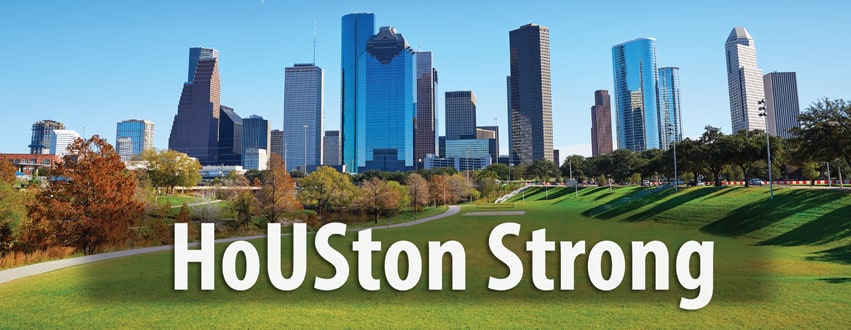
Updated September 13, 11:05 a.m.
Hurricane Harvey hit the Texas coast as a Category 4 storm near Rockport the night of August 25. Although soon downgraded to a tropical storm the following afternoon, Harvey was responsible for more than 60 deaths and up to $180 billion in damage, according to the latest estimates by the governor’s office. On September 6, the US House passed 419 to 3 nearly $8 billion in disaster aid, taking quick action to help victims of the devastating floods.
Depending on their location, some libraries sustained significant damage from the ensuing flood waters, while others escaped with only a little cleanup required. The flood also affected many librarians and other library workers due to the damage to their homes.
Public libraries
Houston Public Library reopened 18 of its 42 locations on September 5, according to an email message from Library Director Rhea Brown Lawson, based on the number of staff members able to return to work, an assessment of the building structure, and the “ability to spread our services as equitably as possible around the city.” The Kendall Neighborhood branch may have taken on up to six feet of water; a full assessment is still not possible, Lawson said, because the three-story building is still inaccessible due to surrounding flood waters. The city’s General Services Department has taken active measures to counteract mold at other closed locations. Some 160–170 staff members had to evacuate their homes, although many have returned. Six or seven library vehicles were also destroyed during the storm.
The Central Library has reopened its first floor to allow access primarily to technology and programs for children and teens. Lawson said that as she walked through the library on September 5, “it felt so good seeing folks embrace services and seem at peace. There were people in quiet corners and others browsing collections. There was laughter from children and the computer area was full. We have not yet deployed our Customer Engagement mobile units across the city, but we hope to restore those services soon.” The Central Library is also providing space to the city General Services Department and Municipal Courts while those spaces are closed and offering free child care to city employees.
Lawson said she plans to reopen additional locations each week as they are repaired or as staff can return to work.
Nineteen of the 26 branches of the Harris County Public Library reopened on September 1 for emergency relief purposes only—for residents to fill out FEMA forms, use computers or internet, charge cellphones, or make use of a quiet, air-conditioned spot. Four branches are closed until further notice: Baldwin Boettcher, Barbara Bush, Katherine Tyra @ Bear Creek, and Kingwood. The library opened a pop-up library at the NRG Stadium to give evacuees some diversion with books for all ages, storytimes for kids, a 3D printer for informal edutainment, and a bank of laptops with internet access.
Initial reports indicated that the Aransas County Public Library in Rockport was damaged, and it has not reopened. Collections at the William R. “Bill” Ellis Memorial Library in Port Aransas are a complete loss, according to a Facebook post. The Port Arthur Public Library is closed until further notice. The Victoria Public Library reported some damage but is expected to reopen soon. The Beaumont Public Library System is closed until further notice; damages are unknown, but staff are working to reopen it. Galveston’s Rosenberg Library reported some water damage to its carpeting, but reopened on August 30.
Academic libraries
University libraries fared relatively well during the storm. The Texas A&M University at Galveston campus suffered little damage and reopened September 4. Classes at Rice University and the University of Houston began on September 5; neither Rice’s Fondren Library nor Houston’s M. D. Anderson Library reported any significant damage, although the latter at one point had an inch of water in its basement and announced that library laptops, equipment, and most study rooms were temporarily unavailable. Many University of Houston students and faculty living in the area lost their homes or cars and suffered through a nightmarish week as the city essentially shut down. Many students at both universities volunteered to work at local shelters, at the Houston Food Bank, and as demolition teams to help storm victims clear out damage..
Remnants of Harvey visited Kentucky early on September 1, leaving the Raymond Cravens Library at Western Kentucky University in Bowling Green with an inch and a half of water on one floor due to groundwater seepage. Library books on the bottom shelves had been raised, resulting in little damage.
School libraries
Elementary and secondary school students in Houston will not return until September 11. NPR reported September 6 that nearly 25% of all school buildings suffered some damage. The Houston Association of School Librarians has been helping to deliver posters on how to access ebooks to community shelters in the NRG Stadium and other neighborhoods.
Museums
The Rockport Center for the Arts, an art center and 10,000-square-foot sculpture park near Corpus Christi, has sustained “serious external damage,” wrote director Luis Purón in a Facebook message. Considering the extent of the storm, many of the region’s other museums have survived relatively unscathed. The Museum of Fine Arts Houston, the Menil Collection, and the Galveston Arts Center are in good shape.
How to help
The Texas Library Association (TLA) and Texas State Library and Archives Commission are working together to coordinate a response for damaged libraries across the Gulf Coast region. TLA has a disaster relief fund that is actively seeking contributions. Hundreds of individuals and companies have donated to the fund, and offers of books, furniture, volunteer assistance, computers, and preservation services are coming in regularly to TLA. The two organizations have also set up the Texas Library Recovery Connection, an online sharing system to bring together assisting organizations with libraries needing help.
Multiple organizations are also accepting funds, goods, and services to help residents affected by the flooding. FEMA offers some fact sheets on salvaging water-damaged family valuables and damaged family treasures.
Calcasieu Parish Public Library in nearby Lake Charles, Louisiana, has set up a Harvey disaster resources page on its website to provide information on how to file for disaster assistance, apply for food stamps, and find shelter. Dallas Public Library also has a webpage of relevant resources.
Hurricane Irma
ALA and the library community are supporting response and recovery efforts for libraries damaged by Hurricane Irma. ALA members are encouraged to assist colleagues in Florida and other areas by participating in local fundraising efforts. The Florida Library Association has set up a Florida Libraries Disaster Relief Fund. ALA’s Chapter Relations and International Relations Offices will provide additional information as funds are set up for damaged libraries. ALA also offers a list of resources for dealing with natural disasters at Libraries Respond.


